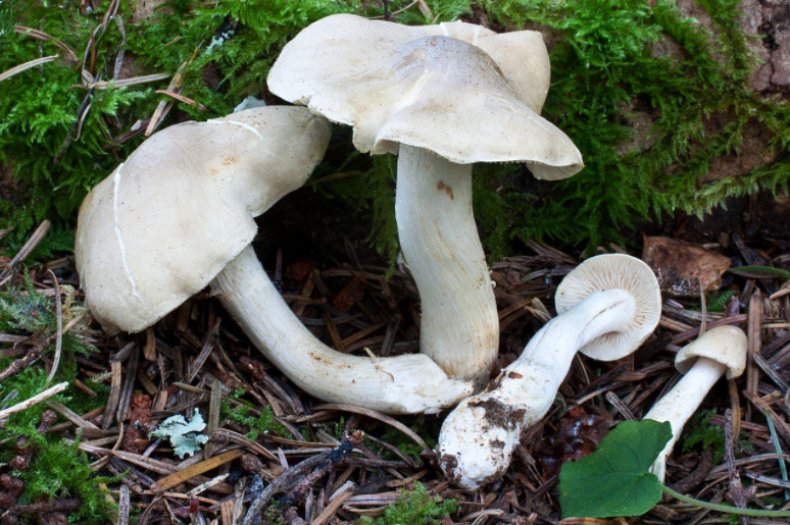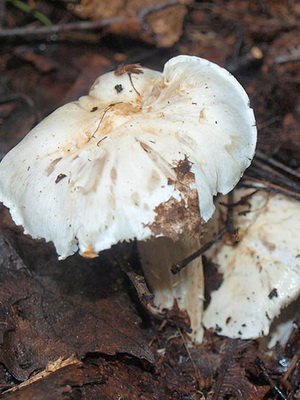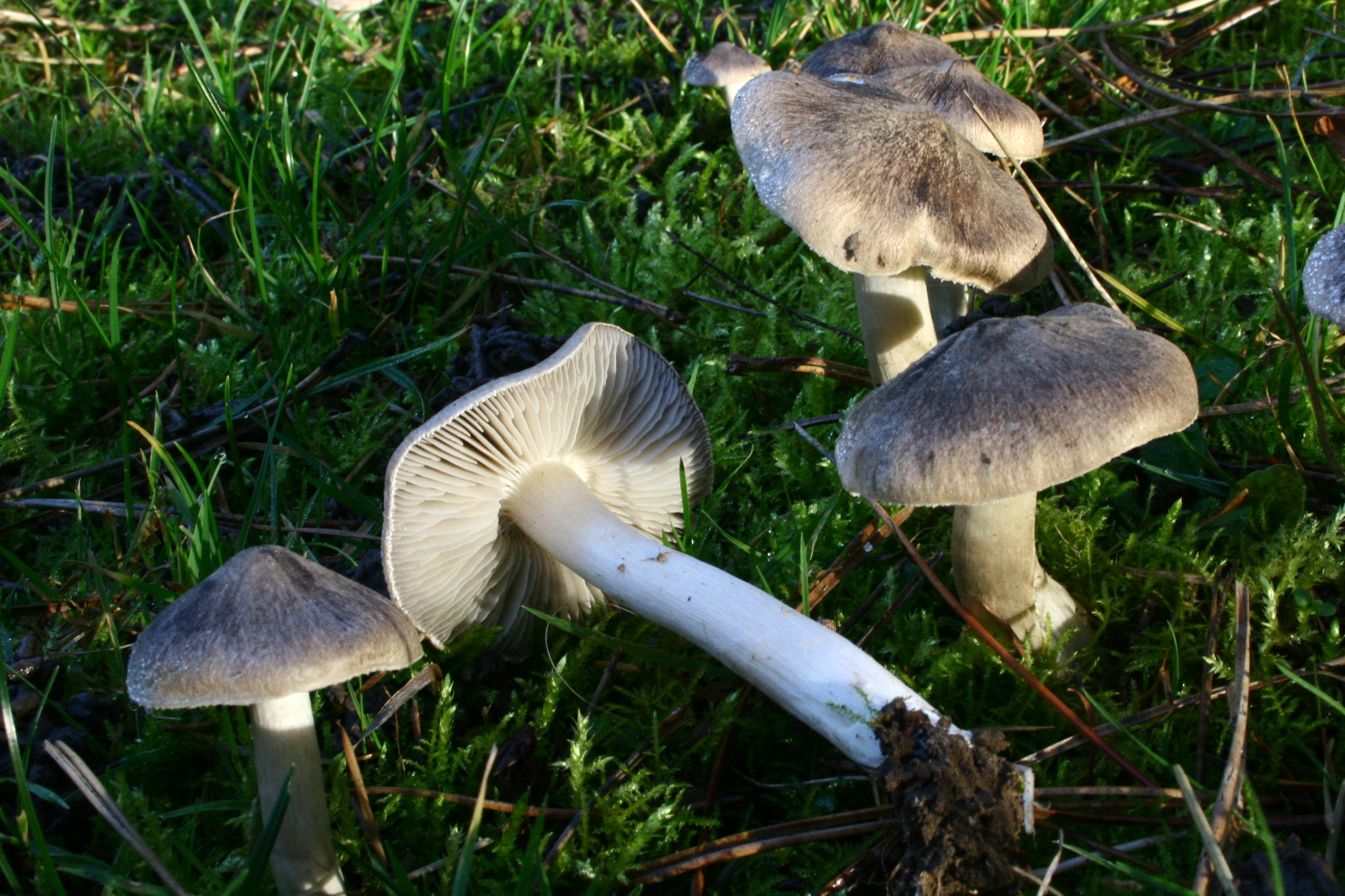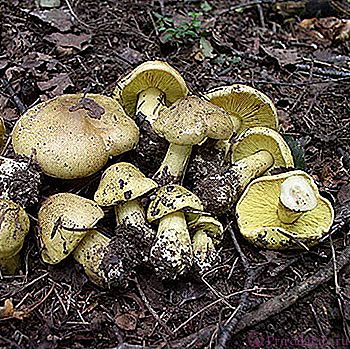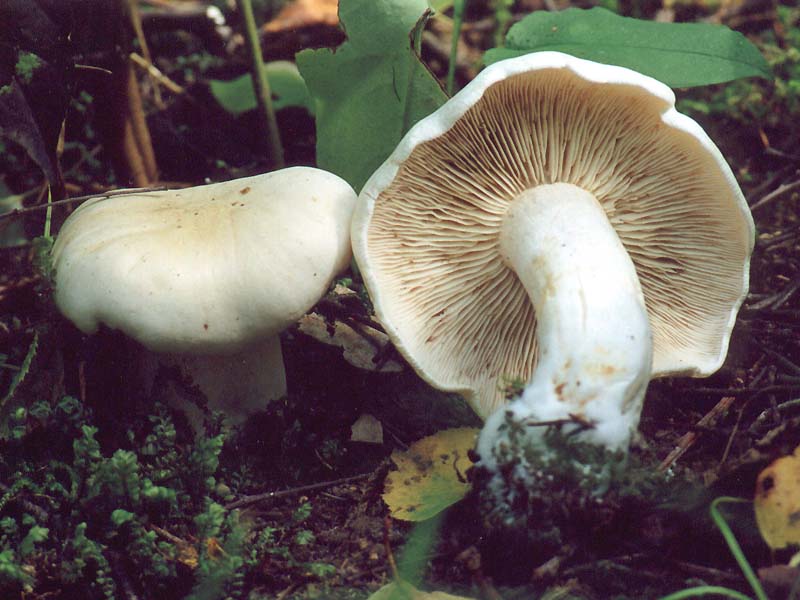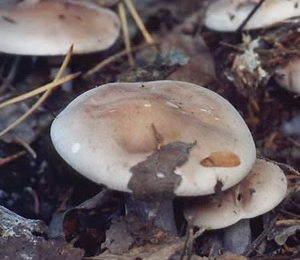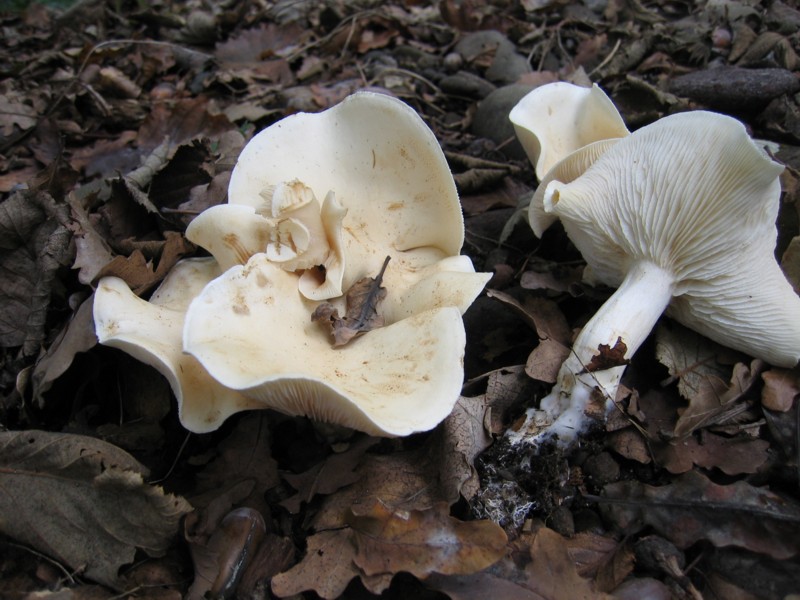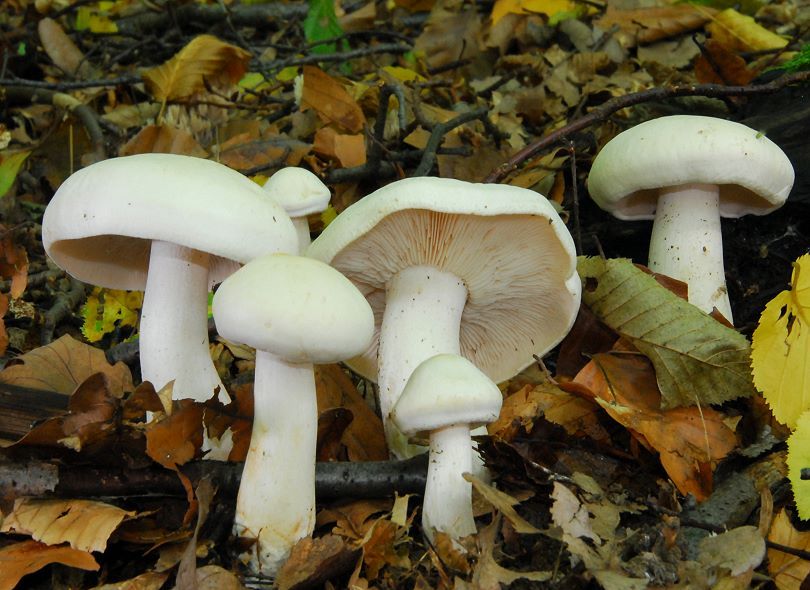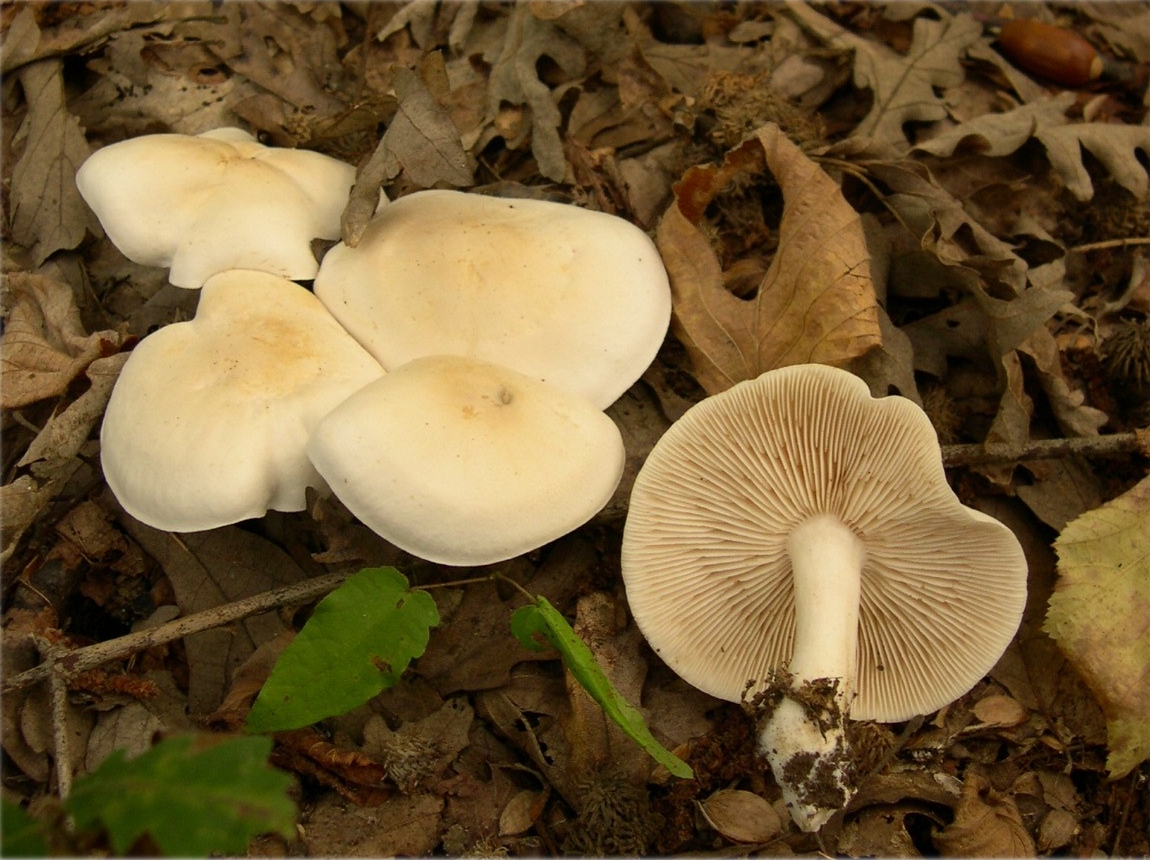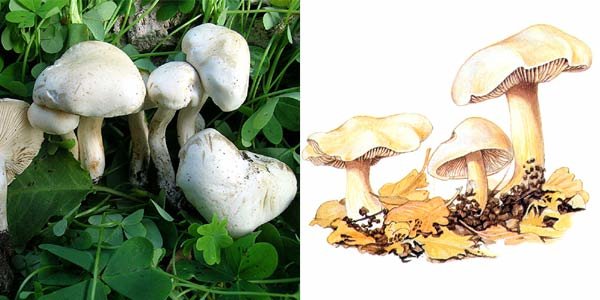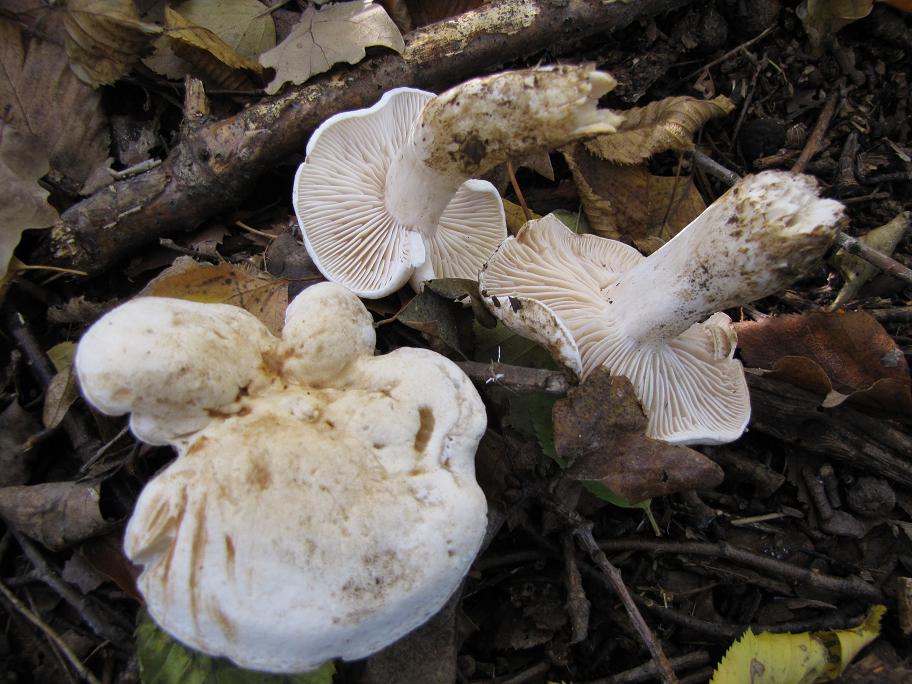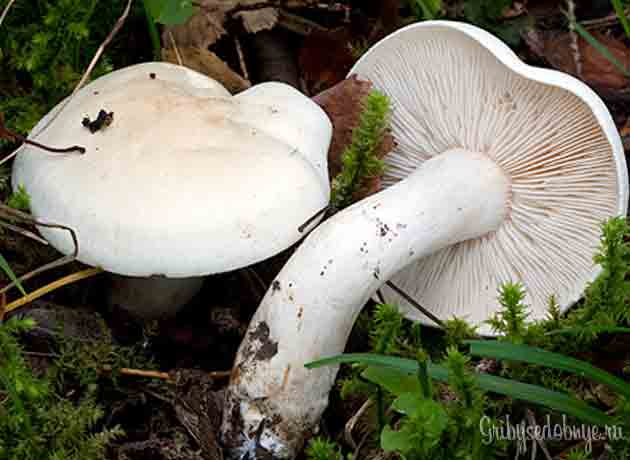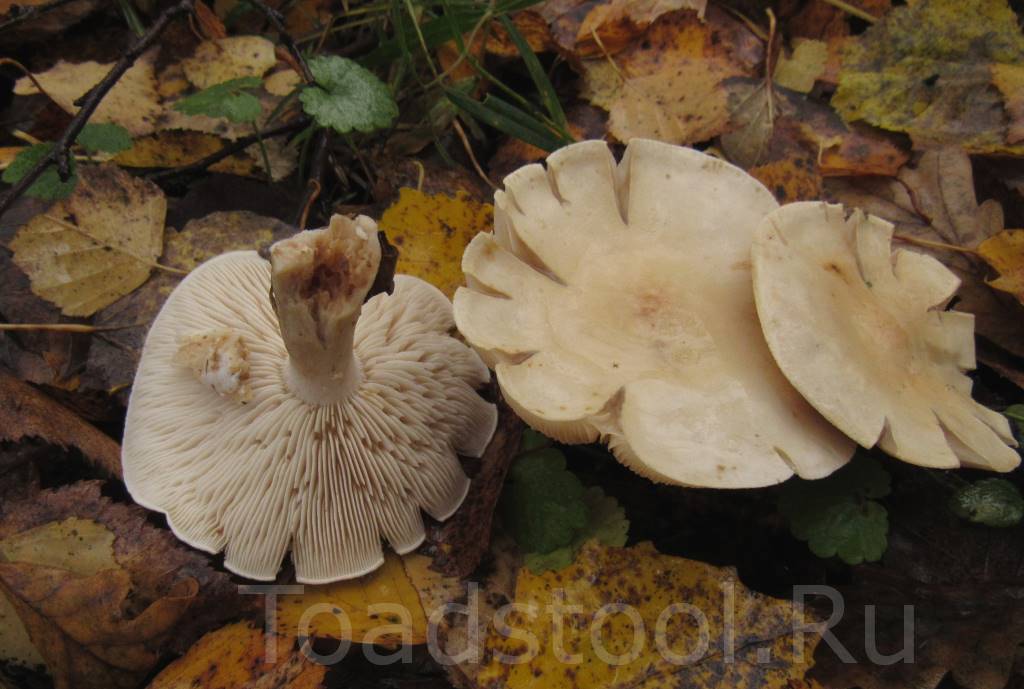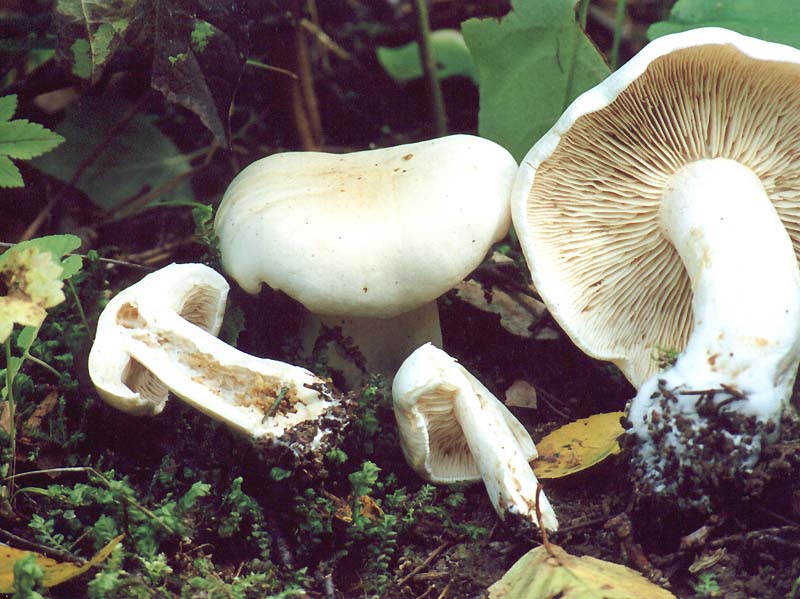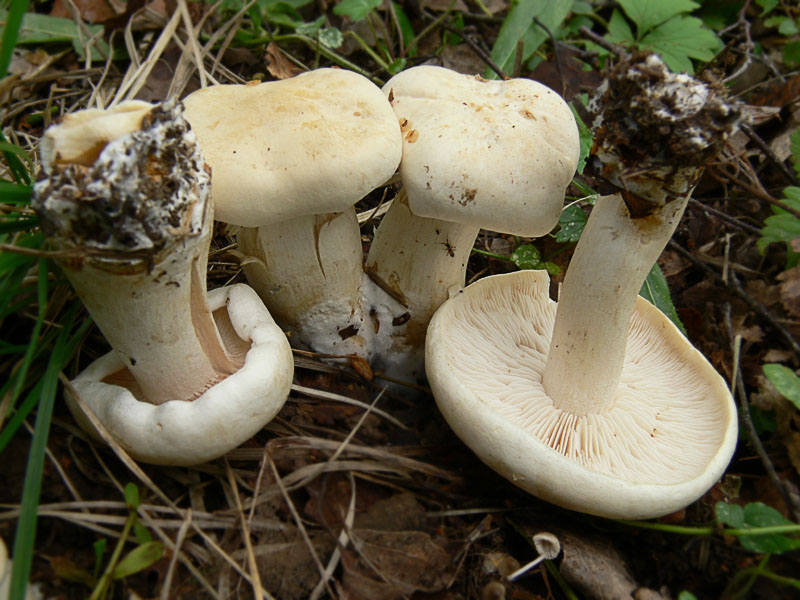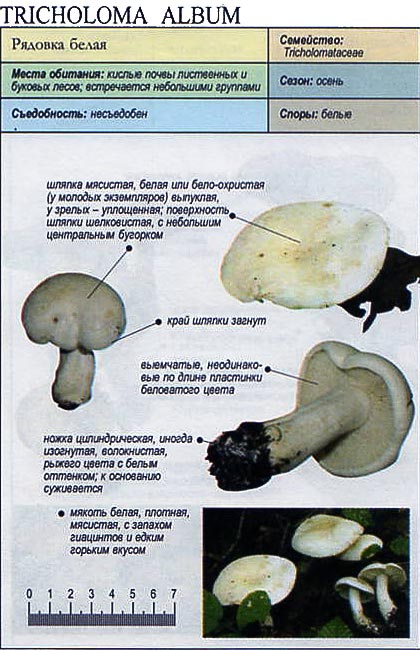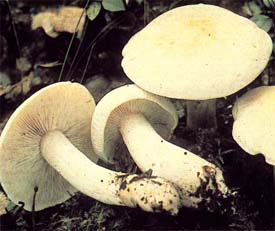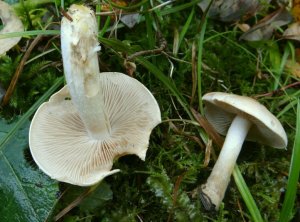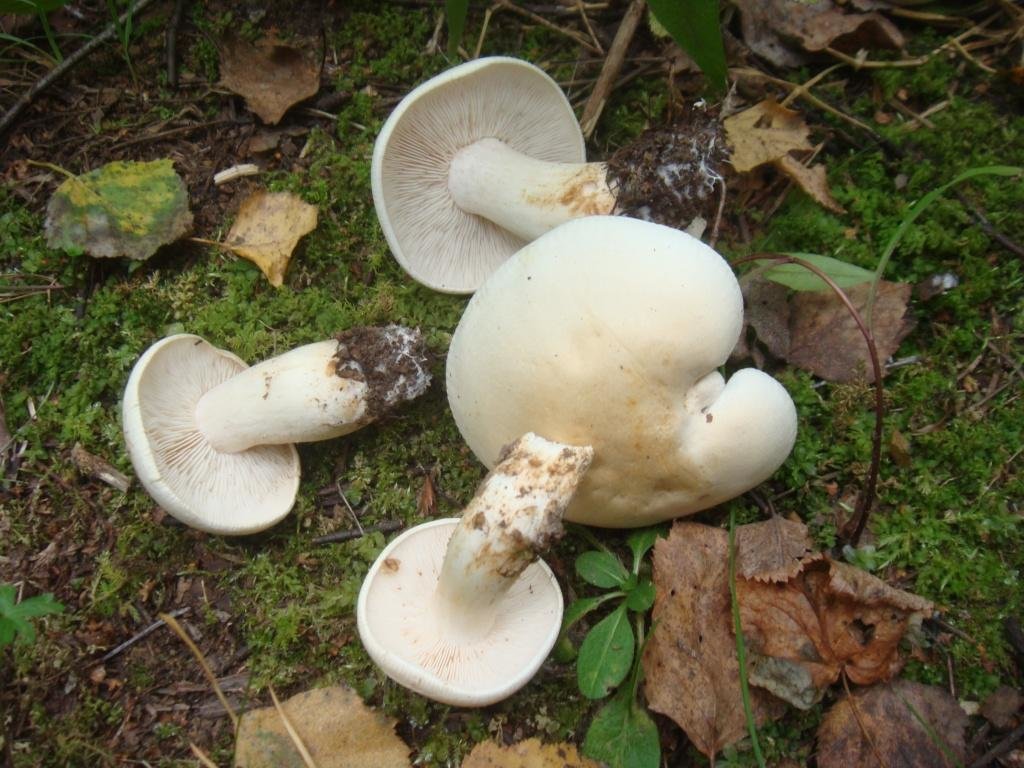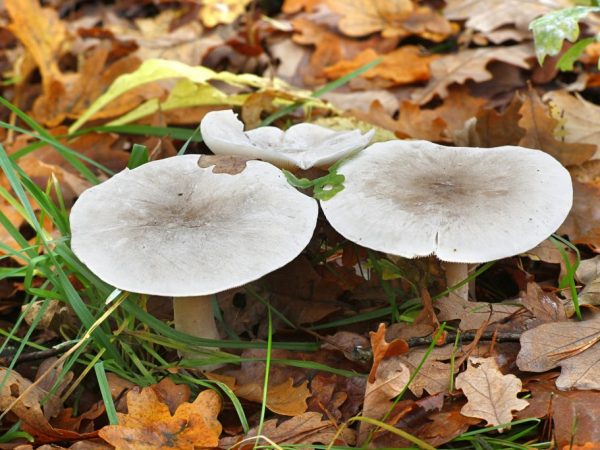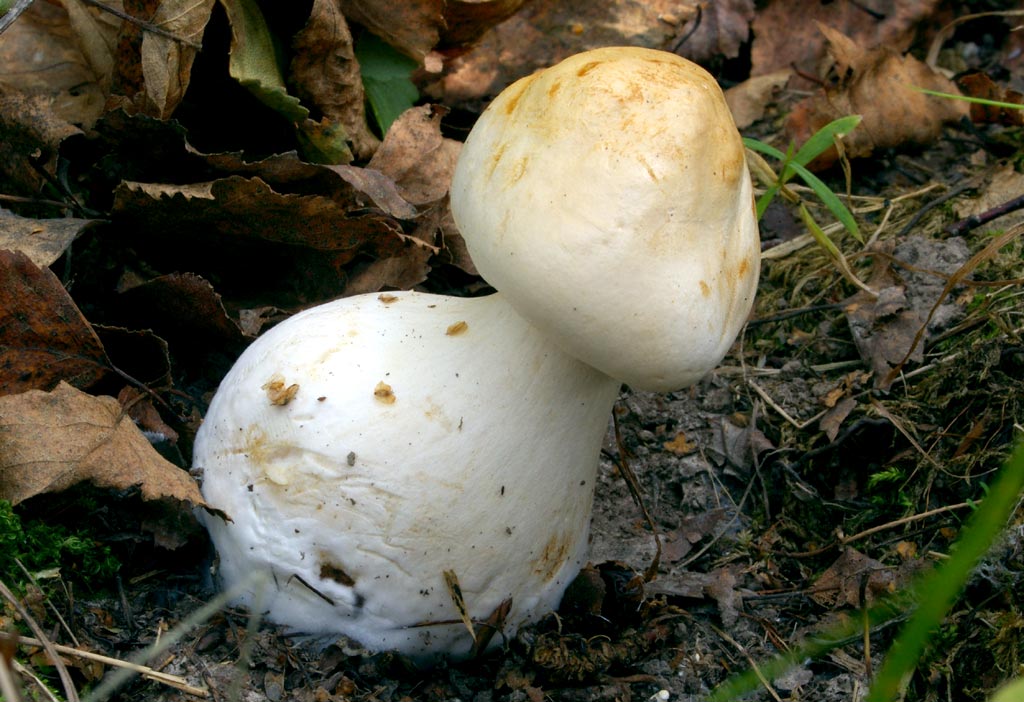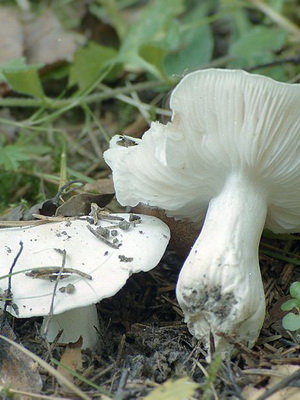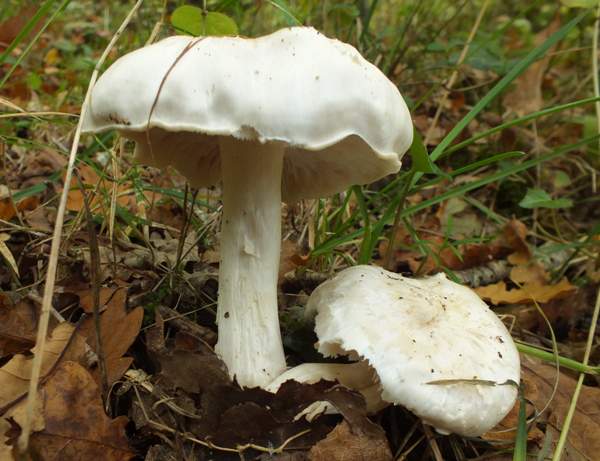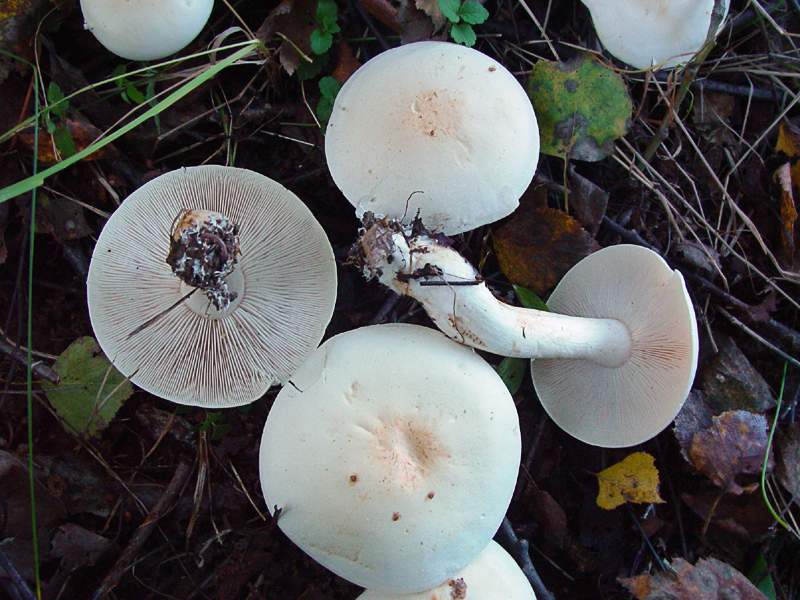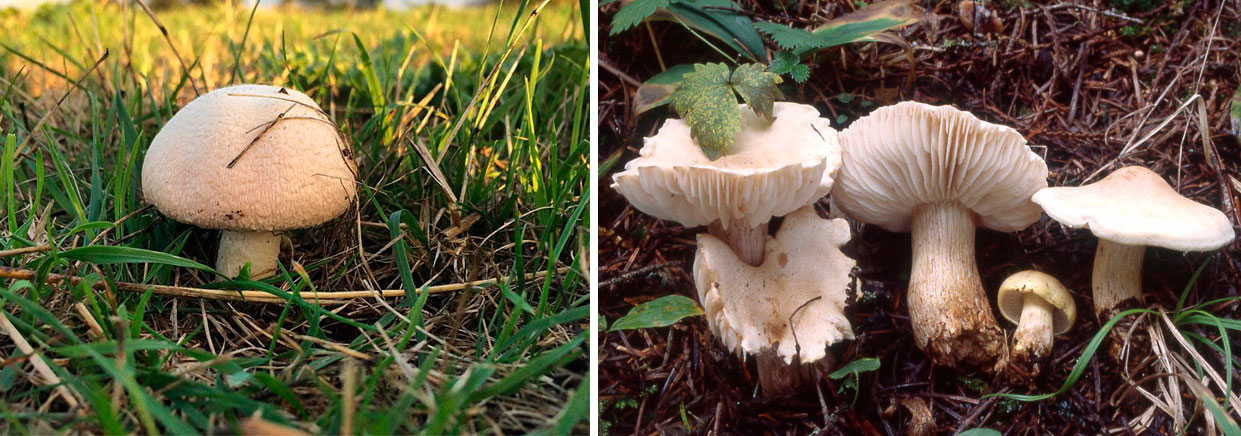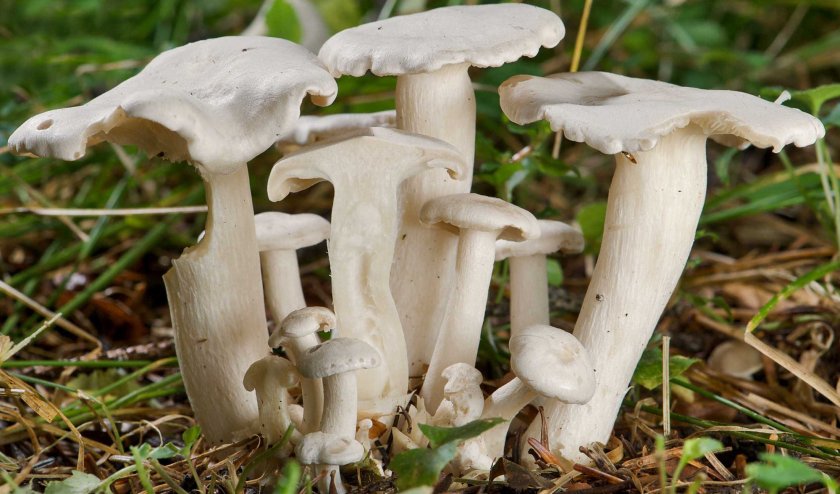Mushroom ryadovka purple: photo and description
Family: Ordinary (Tricholomataceae).
Synonyms: naked lepist, titmouse, cyanosis.
Description. One of the most popular and most delicious late autumn rows.
Photo and description of the purple ryadovka gatherings with other types of these mushrooms, however, have some differences.
Pay attention to the photo of the purple row: the hat is 4-20 cm in diameter, flat-convex, with a thin curved edge. In a healthy fungus, it is naked, smooth, watery, moist, thick-fleshy
The color of the cap is necessarily with a significant proportion of violet: bright, dark or purple-violet, sometimes with an admixture of brown, in the center - brown-violet. The plates are frequent, purple, later light purple to pale lilac. The pulp is thick, dense, bright purple, with age it fades like a cap or even stronger, the taste and smell are pleasant. Leg 3-10 X 0.7-3 cm, dense, cylindrical, slightly thickened below.
In the photo of the mushroom, the purple ryadovka clearly shows that at the base the leg is covered with a purple-brown felt mycelium. At an early age, it is purple, later brightening, whitish-mealy under the cap, sometimes hollow with age.
Similar species. It differs from blue- and violet-colored cobwebs, first of all, by the absence of a clavate expansion at the base of the leg and a cobweb private veil that protects the plates at the cobwebs.
Medicinal properties: The mushroom is high in vitamin B1, stearic acid and ergosterol.
The extract of the cultural mycelium of this talker has anticancer properties and inhibits the growth of sarcoma-180 in laboratory animals by 90%, Ehrlich's carcinoma by 100%. It has a strong cytotoxic effect on human cells of the L-1210 tumor line; in culture, it can inhibit the development of MCF-7 breast cancer and Walker 256 sarcoma.
Antibacterial action is directed to both gram-positive and gram-negative bacteria. The growth of E. coli, Staphylococcus aureus, Streptococcus pyogenes and Streptococcus enteretidis is inhibited. Antifungal activity was also found (suppresses Candida albicans).
Contains vitamin B1, which is effective against beriberi disease, and lowers blood glucose levels. Currently, on the basis of purple ryadovka, a dietary drug is being developed to control hypoglycemia.
In addition, ryadovka violet has anti-inflammatory and immunomodulatory activity, promotes platelet aggregation and increases the body's resistance to the influenza virus.
Traditional Medicine Uses: In Chinese medicine, regular consumption of food is believed to help maintain the nervous system. It is also used to regulate sugar metabolism, treat spleen, rheumatism and dermatophytosis of the legs.
Cooking Applications: Like all edible rows, the mushroom does not require (from my point of view) pre-boiling. Used for preparing first and second courses, snacks, salads, fillings.
Information about the allergenicity or toxicity of the violet row, which appeared at different times from different authors, has now been refuted by a number of studies. However, you should be aware that bruises are one of the most active bioaccumulators of anthropogenic pollution (ranked third after May mushroom and pigs), primarily heavy metals (tin, copper, mercury, cadmium). Therefore, you should avoid collecting them in city parks and in forests near industrial sites.
Interesting Facts. It is noteworthy that about a month before the beginning of fruiting, the purple ryadovka mycelium emerges on the surface of the forest litter. At first, the mycelium is almost white, pale bluish, but rather quickly turns into a light purple color characteristic of the fungus itself.Having found such a purple "cotton wool" enveloped in rotten needles and leaves, you can confidently take a note of the cherished place and come here in season for a guaranteed harvest.
The blues owe their pleasant fruity sweetish taste to the sugar trehalose, which is also found in meadow mushrooms.
Cultivated in a number of countries.
Inedible species
These are not dangerous mushrooms, but it is impossible to eat them because of the pungent taste and unpleasant pungent odor, which are not destroyed during processing.
The most common:
- Soapy;
- White;
- Sulfuric (sulphurous);
- Rough;
- White-brown (white-brown).
Soap (Tricholoma saponaceum, Agaricus saponaceus)
The most important difference is the sharp "aroma" of laundry soap. And only then you can make out the rest of the signs: the head is smooth, olive-yellow in color with a burgundy center and pale edges. The inside is yellowish, reddening at the cut.

White (Tricholoma album)
In some reference books, this species is classified as weakly toxic. In any case, eating it is problematic: it stinks painfully, the sharp aroma of the radish becomes unbearable when cut. The cap, leg and flesh are milky in color; when broken, it immediately turns pink.
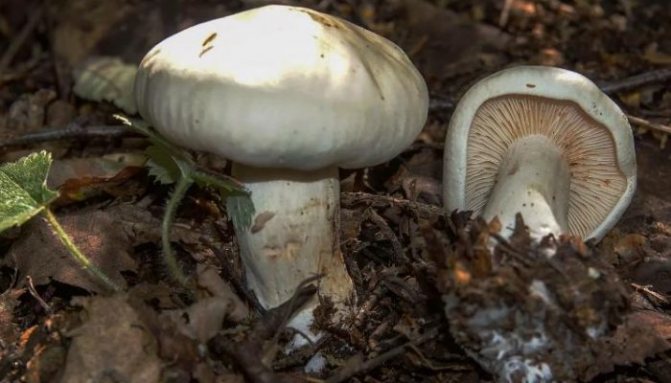
Sulfuricum (Tricholoma sulphureum)
Synonyms:
- sulphurous;
- sulfur yellow.

| Head | flat-spread, even bowl-shaped with waves around the edge. The surface is small velvet, poisonous yellow, with darkening at the center. The plates are lemon yellow. |
| Leg | The leg is bright yellow in the upper part, in the lower part it is brownish-yellow with longitudinal fibers. |
| Smell | strong, unpleasant hydrogen sulfide, tar or acetylene. |
| Pulp | Poisonous yellow, dense. |
Description of the edible mushroom
The scaly row is also known as the brown or brownish row, the fibrous-scaly row, the Sweet. The Latin name for the mushroom is Tricholoma imbricatum. Belongs to the genus Tricholom (Ryadovok), the Tricholomataceae family.
The cap reaches a diameter of 4-10 cm, dark brown with a reddish or reddish tint, pale towards the edges, covered with scales. Young mushrooms have rounded bell-shaped caps with turned-up edges. In mature ones, they are prostrate, with a small tubercle in the center.
The hymenophore, or the lower part of the cap, is lamellar. The plates are wide, often located, adherent to the peduncle, white. As the fungus grows, their color changes to beige, then to brownish with brown blotches, as if the plates are covered with specks of rust.
The spore powder is white and consists of wide-oval spores.
The pulp at the break is white, sometimes darkens in the lower part of the leg, thick, of dense consistency. Has a barely discernible smell of fruit, the taste is slightly bitter, mealy.
The leg reaches a length of 10 cm, a thickness of –1.2-2.5 cm, cylindrical. Often it is clavate, tapering downward and even curved. The surface of the leg is covered with small scales. At the top of light shades, it darkens downward, at the base it is covered with fluffy mycelium. In young fruiting bodies, the leg has a dense structure, but over time it becomes hollow.
Slastushka was first described by the Swedish biologist Elias Magnus Fries in the first volume of Observationes Mycologicae in 1815. At the time, the founder of the fungal taxonomy named it Agaricus imbricatus.
Time and place of fruiting
This fungus is found in temperate climates in mixed, more often coniferous forests with a predominance of young pine stands from late July to October — early November. The peak of fruiting occurs in September. Sweets like soils with an acidic and neutral reaction, they grow in large groups in dry, well-lit places. They are also found at the side of forest roads.
Edible rows
These include:
- Matsutake;
- May;
- Gray;
- Greenfinch;
- Lilac-legged;
- Earthy;
- Scaly;
- Giant;
- Bored.
Matsutake (Tricholoma matsutake)
Synonyms:
- shod;
- Japanese truffle;
- pine mushroom.
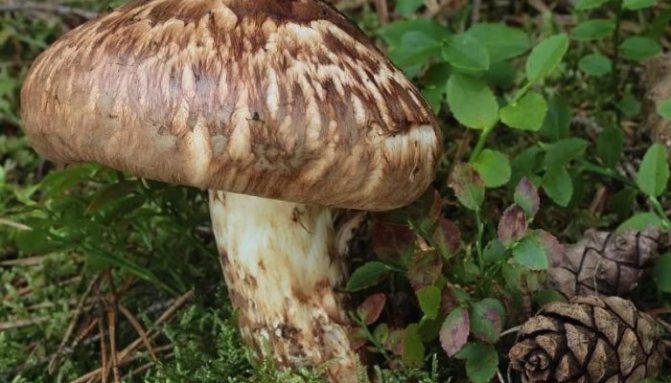
| Head | Creamy brown, silky with large dark scales and light beige plates. Flat, thickened in the center, cracks with growth. The edges are torn. |
| Leg | with scales, white at the cap with a transition to the color of cinnamon to the ground. There is a film ring under the cap. |
| Smell | Bright, pine with a touch of cinnamon |
| Pulp | Beige or milky |
| Where does it grow | In the pine forests of the Urals, Siberia, the Far East. |
May row (Calocybe gambosa)
Synonyms:
- may mushroom;
- kalotsibe may;
- george mushroom.
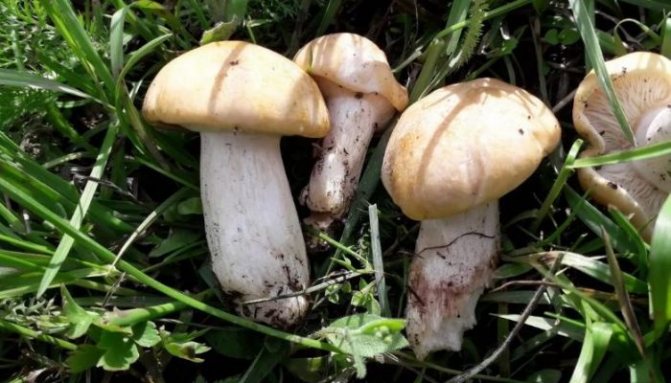
One of the most coveted trophies of the spring "mushroom free". It appears on the 20th of May, and in the sun even at the end of April. It grows until the last decade of June.
| Head | Hump-shaped, then semi-spread, silky, milky in color. Older specimens have diluted ocher with white plates. |
| Leg | Cylindrical of medium thickness, slightly yellowing |
| Smell | Pleasant, freshly ground flour |
| Pulp | White, firm texture, fleshy, without darkening and discoloration during cooking. |
They are easy to distinguish by their unpleasant odor and time of appearance (late August - early October)
Gray (Tricholoma portentosum)
Synonyms:
- streaked;
- sirushka;
- undergrowth;
- gray sandpiper.
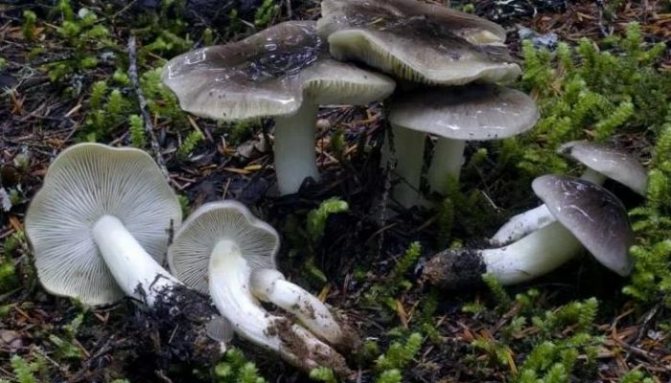
One of the best late autumn mushrooms. Approved for sale on official agricultural markets.
| Head | Broadly bell-shaped with a lowered edge and white plates, in mature it is flat with a thickening in the center, with a wavy edge and greenish or grayish-white plates. The skin is smooth, slippery, with radial dark gray streaks. Color - gray or gray-brown, in the center - black, to the edge - light gray. |
| Leg | smooth, columnar, less often clavate, yellowing when pressed. |
| Smell | Weakly powdery. |
| Pulp | Soft, white, grayish. |
She has:
- gray narrow cone-shaped head;
- more dark strokes on the hat, no lightening towards the edge.
Greenfinch (Tricholoma equestre, flavovirens)
Synonyms for this row:
- Green;
- Knightly;
- Golden;
- Lemon;
- Zelenka;
- Jaundice.

| Head | At the beginning it is convex, with the edge curled down. When ripe, it is flat-spread with a hump in the center and a wavy edge. The skin is shiny, with small radial fibers, in the center they are collected in scales. The surface and plates are from lemon yellow to olive or rusty brown. |
| Leg | Cylindrical, with light beige longitudinal fibers. |
| Smell | Strong smell of fresh dough. |
| Pulp | White, pale yellow, does not change color during cooking. The taste is soft, mealy. |
For information! This mushroom has an inedible double - the spruce row (Tricholoma aestuans). It differs from edible greenfinch:
- smell (unpleasant);
- the shape of the cap (bell, without an obvious tubercle);
- thin long hollow leg;
- less fleshy cap.
In a pale toadstool, it has:
- "Skirt" at the hat;
- Thickening at the root;
- The remains of the blanket at the butt, i.e. grows as if from a calyx.
Purple-footed (Lepista personata, Lepista saeva)
Synonyms:
- Bluefoot;
- Blue root;
- Two-color flower;
- Lilac Lepista.
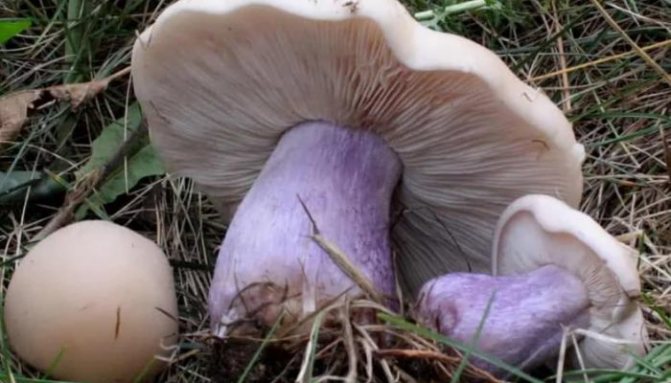
| Head | bowl-shaped fleshy, yellowish with a tucked lavender edge. The plates are beige. |
| Leg | Thick, strong, lavender or with lilac strokes. |
| Smell | Pleasant and delicate fruit aroma. |
| Pulp | White, lavender on the cut. |
Poisoning by rows
Despite the fact that among the poisonous ryadovki there are no deadly ones, it is quite possible to get poisoned by them.

Poisoning can be caused by:
- the use of poisonous mushrooms;
- the wrong way to prepare conditionally edible rows;
- picking mushrooms near roads, in city parks, near industrial enterprises with hazardous industries. Rows very actively accumulate salts of heavy metals from the atmosphere and soil, which is extremely dangerous for humans.
Symptoms
Signs of poisoning will begin to appear between 30 minutes and 2 hours after the mushrooms have been eaten.

There are:
- profuse salivation;
- cold sweat;
- weakness;
- nausea;
- heaviness in the stomach;
- indomitable vomiting;
- diarrhea.
Respiratory depression, confusion, serious damage to the internal organs of ryadovki do not cause, therefore, the victim may well begin actions to save himself. And the sooner he does it, the faster he will recover.
And of course, call an ambulance as soon as possible.
First aid
First of all, you need to remove toxins that have entered the stomach before they are absorbed into the blood.

For this:
- drink as much water as possible, preferably salted (1 tsp per liter of water) or a slightly pink solution of potassium permanganate;
- induce vomiting by pressing on the root of the tongue;
- then take any adsorbent - activated carbon, Filtrum, Smecta.
In case of poisoning, the body is dehydrated, so the victim must be given a lot of liquid.
To minimize the degree of poisoning, and the recovery process is faster, take as a rule:
- Never eat large portions of new mushrooms.
- Do not mix new mushrooms with already known ones.
- Save small pieces of new mushrooms for toxicity testing.
Description and how to distinguish
The cap of the sulfur mushroom is convex and flat-spread. The poisonous gray row has curled edges. The color of the cap can be off-white, brownish, or gray. The pulp of the mushroom is white, has a flour smell and taste. A distinctive feature is gray scales, densely located on the cap. Mealy bloom on the leg.
The plates of the fungus are wide, they grow to the stem and may have a greenish-yellow tint. The spore powder of this mushroom is white, and the spores themselves are smooth and rounded.
The stem of the mushroom is about 4-8 cm, it is quite dense and mealy, and at the bottom it becomes brown.
Please note that poisonous mushrooms should not be eaten. If you eat it, then after 2 hours a person has a gastrointestinal upset and vomiting.
It is especially dangerous due to its pleasant smell and taste. Often people do not think that it can be poisonous. Such a mushroom is very similar to the long-rooted white champignon and the earthy-gray ryadovka.
Varieties of rows
In nature, there are a large number of varieties of rows, which have many differences not only in appearance, but also in properties.
The list of such types is very large, however, we will present only the most famous and most common:
• Green row (Zelenushka, Zelenka).
• Ilmovaya ryadovka.
• Brown row.
• Bluish and pigeon ryadovka.
• Brown-yellow and water-spotted row.
• Earthy gray and yellow-red.
• Tied and fused.
• Bored and purple.
• Poplar and violet.
• The row is yellow poisonous.
• Row white poisonous
Please note that some of the species presented include both edible and inedible rows.
That is why, when you go to the forest for mushrooms, it is important to understand them very well.
Where does the rowing grow?

If you want to know exactly where the poisonous ryadovka grows, so as not to bump into it, you should pay attention to the fact that they can most often be found in those types of terrain, which are characterized by sandy soil covered with moss. Very often they grow in coniferous forests and pine forests, therefore such mushrooms are called podosnovikami.
Such mushrooms can also be found in parks and gardens.
Consequently, the poisonous ryadovka can have different upholstery places. But most often it can be found in a coniferous or deciduous forest, on the territory of fields and meadows.
Ryadovka poisoning
If you still eat a poisonous mushroom and feel unwell after a while, you should not panic. You need to act as if this is a simple departure and then you will be able to improve your health and remove the poison from your body.
Diarrhea, nausea and vomiting, which appeared within 2-4 hours - the first sign of poisoning. In this case, you should immediately call an ambulance in order to save the life of yourself or the person who ate the red poisoned mushroom.
If you are far from the city or there is no way to call an ambulance, you need to flush the stomach with potassium permanganate. It will remove all toxins from the human body and after a while he will feel much better. Remember, poisonous tiger mushrooms are no joke. Therefore, go to the forest for mushrooms only with a person who understands them well.
Inedible types of rows
Pseudo white
(Tricholoma pseudoalbum)
- It inhabits singly or in small groups in mixed or deciduous forests.
- It grows from August to October.
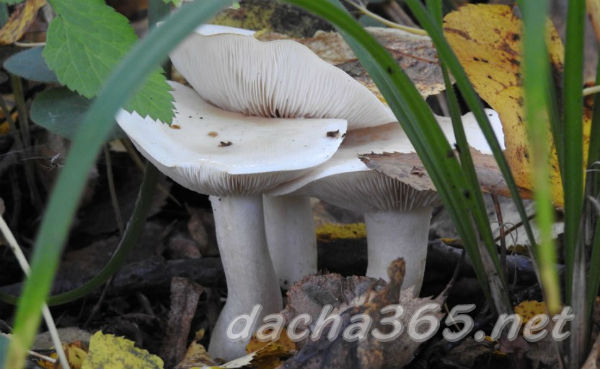
- At the beginning of growth, the cap is hemispherical, later becomes convex, reaching a diameter of 3-8 cm. Its color is white, cream or slightly pinkish.
- The leg grows up to 3-9 cm in height and 1.5 cm in width. It is the same shade as the hat: white, pinkish or creamy white.
- The pulp with a mealy odor, white at first, then slightly yellowish.
- The plates are of a creamy shade, at first slightly adherent, and then almost free.
- It has an unpleasant taste, therefore it is not eaten.
This species is similar in shape and size to the May row (Tricholoma gambosa). But the latter has greenish or pale pink areas on the cap.
Smelly
(Tricholoma inamoenum)
- Grows in groups or singly in moist areas of deciduous or mixed forests.
- The growing season is from June to October.
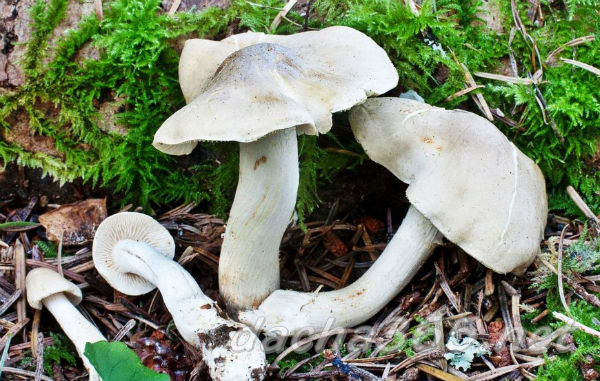
- The cap usually reaches 3-8 cm in diameter, but can grow up to 15 cm. Its surface is smooth, often bumpy, ivory or white, and as it grows, brownish or yellowish spots appear. At the beginning of growth, the cap has a hemispherical shape, and with age it is convex, with slightly wavy edges.
- The length of the leg grows up to 5-15 cm, and the thickness is up to 2 cm. It has a cylindrical shape, elastic and dense, the color is identical to the cap.
- The flesh is white, fleshy and firm. The representatives of this species are distinguished by a strong smelly smell, which is inherent in both young and old mushrooms. The smell is similar to light gas.
- Adherent mid-frequency plates can be white or cream in color.
- Because of the stench, these mushrooms are not edible. Even cooking does not eliminate it.
Often, at the beginning of growth, you can confuse the smelly rower with edible sulfur (Tricholoma portentosum). But it lives up to the name and the smelly smell is hard to miss. And the gray ryadovka has a pleasant mushroom aroma.
Similar species
A species that forms mycorrhiza with pines. It looks like a scaly leg and a whiter hymenophore. Quite rare, poisonous.
Also grows in pine forests. It has a shorter stem and less pronounced scales on the cap. This species is conditionally edible.

1-Row of Joachim 2-Row green
Has black fibers in the hymenophore, which itself is almost white. Surface color - with a greenish tint. The mushroom is poisonous.
Almost identical to green, but different in that its color darkens with age, and the flesh is pinkish and bitter. This mushroom is poisonous.

1-Row green-yellowish 2-Row spruce
Another "pine" species, lighter in color, is poisonous.
It has no scales on the cap, its flesh is distinctly yellow. The smell is unpleasant and the taste is bitter. Like most twins of deciduous ryadovka, it lives in a coniferous forest belt. Inedible due to its bitter taste.

1-Row Ulvinen 2-Row gray-yellow
It practically does not differ from sulfur-yellow, it can only have a pinkish tint of the cap. Poisonous.
Has a white coloration of the legs and plates, grows in association with conifers. Edibility has not been established.

1-Row toad 2-Row Auverne
Has a light, almost white hymenophore and almost black scales on the cap. Edibility has not been established.
Previously, the species was called "ryadovka slightly different" - it has a greener color, white hymenophore and a smooth cap without scales. The species is characterized by conditional edibility.

Row olive-colored
It looks about the same as the above-considered melanoleuca, slightly different, but is characterized by a radial fibrous cap and greenish spots on the stem. Conditionally edible, according to some sources, inedible.
It looks the same as the 2 views above, only the leg is slightly shorter. This species forms mycorrhiza with oaks and beeches. The edibility of this species is unknown.

1-Row different 2-Row green-colored
Conditionally edible. Differs in the presence of dark scales on the surface of the cap. The taste of this mushroom is not bitter, but mealy.
Edible. It differs in that the build-up in the center of the cap is not conical, but flatter, and the surface of the cap often cracks.

1-Row silver 2-Row gray
Inedible.It is distinguished by a uniform color of the cap, as well as an intense smell of laundry soap.
Conditionally edible. It also smells unpleasant, the leg is greenish or yellowish.
Edible. There is a brownish tint in the color of the cap. On the edges of the cap there are remnants of velum (in young specimens).

1-Row soap 2-Row different 3-Row of land
As you can see from the above, the pointed row has a number of "doubles", among which there are also edible specimens
Therefore, when collecting edible rows, it is important not to confuse them with a pointed row


